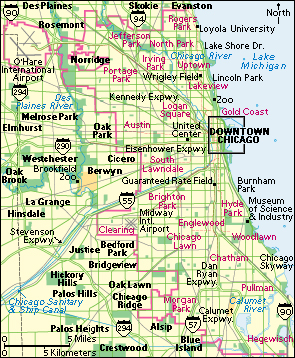Chicago Sanitary and Ship Canal connects Lake Michigan with the Des Plaines River by way of the Chicago River. The canal, which is sometimes called the Chicago Drainage Canal, carries Chicago’s treated sewage into the Des Plaines River, near Lockport, Ill. The Des Plaines flows southwest and joins the Illinois River.

The Mississippi River receives the Illinois River and carries its waters on to the Gulf of Mexico. Before completion of the canal in 1900, Chicago sewage was dumped into Lake Michigan . This caused pollution of water used in the city water system.
The natural course of the Chicago River is eastward, through downtown Chicago into Lake Michigan. Engineers made the river flow westward through the Drainage Canal. The river is now an outlet instead of an inlet of Lake Michigan. It was the first river in the world to flow away from its mouth.
Chicago’s sewage is treated in plants of the Metropolitan Water Reclamation District of Greater Chicago, then turned into the channel. The Chicago Sanitary and Ship Canal is 30 miles (48 kilometers) long, 202 feet (62 meters) wide, and 24 feet (7.3 meters) deep. The rate of flow is controlled by sluice gates at Chicago Harbor and at the O’Brien Lock in the Calumet River, and by pumps at Wilmette Harbor.
The canal was built between 1892 and 1900. It forms a link in the Illinois Waterway, a part of the Lakes-to-Gulf Waterway.
